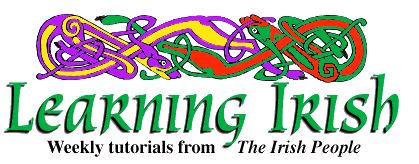
Irish Lesson 47
|
Pronunciation Review Similar to the vowel "ó" are the two letters "eo". When this group begins a word, it is pronounced (oh), as in "o". There is no (oo) sound at the end of it. Examples of "eo" at the beginning of a word: eolas (OH-luhs), knowledge; eorna (OHR-nuh), barley; Eochaill (OHK*-hil), Youghal, an Irish seaport; Eoin (OH-in), a form of John. Most consonants, when before "eo", cause a (y) sound to be heard. Examples: beo (byoh), alive; ceo (kyoh), fog; deo (dyoh), end; deoir (DYOH-ir), tear; teo (tyoh), hot; ceol (kyohl), music; feoil (FYOH-il), meat; neodrach (NYOH-druhk*), neutral; geoin (GYOH-in), cry; meon (myohn), mind. If "l, r, s" precede "eo", there is no (y) sound. Examples: leo (loh), with them; reo (roh), frost; gleo (gi-LOH), tumult; seoid (SHOH-id), jewel. In "seo" (shuh), the "eo" does not get its customary pronunciation. In "seó", on the other hand, the "ó" receives a síneadh fada to tell us that it has the (oh) sound: (shoh).
Grammar Another important preposition is "do" (duh), meaning "to" or "for". It is not often used for motion to a place, however. "Chuig" (hig) and "go" (guh) are more common for that. "Do" aspirates the first consonant of the word following it, as does "ar", meaning "on". Examples: Thug mé do Sheán é (hug may* duh hyaw*n ay*), I gave it to John; faigh leabhar do Cháit (feye LOU-uhr duh k*aw*t), get a book for Kate. "Do" combines with "an" to form "don" (duhn), meaning "to the" or "for the", and it aspirates. Examples: Thug mé don fhear é (hug may* duhn ar ay*), I gave it to the man; faigh peann don chailín (feye pyoun duhn k*ah-LEEN), get a pen for the girl. With prepositions, "do" also combines to give: dom (duhm), to me duit (dit), to you dó (doh), to him di (dee), to her dúinn (DOO-in), to us daoibh (deev), to you, (plural) dóibh (DOH-iv), to them Some common forms of speech make use of "do". Here are several: Inis scéal dom (IN-ish shkay*l duhm), tell me a story Cad is ainm duit? (kahd is AN-im dit), What is your name? Seán is ainm dom; John is my name. Ba cheart dó dul abhaile (buh hyart doh duhl uh-VWAHL-e), he should go home.
Vocabulary droichead (DRUH-huhd), bridge thar an droichead (hahrn DRUH-huhd), over the bridge tollán (tuh-LAW*N), tunnel tríd an tollán (TREED un tuh-LAW*N), through the tunnel Inis, ag insint (IN-ish, eg IN-shint), tell insím dó é (IN-sheem doh ay*), I tell it to him Insíonn sé dó é (in-SHEE-uhn shay* doh ay*)), he tells it to him labhair, ag labhairt (LOU-ir, uh LOU-irt), speak labhraím Gaeilge leis (LOU-reem GAY*-lig-e lesh), I speak Irish to him nua (NOO-uh), new ar na mallaibh (er nuh MAHL-iv), recently cheana (HAN-uh), already sáigh, ag sá (SAW*-ee, uh saw*), stick sáim mo cheann sa bhfuinneog (SAW*-im muh hyoun suh vwin-YOHG), I stick my head in the window sánn sé a chos sa doras (saw*n shay* uh k*uhs suh DUH-ruhs), he sticks his foot in the door
Drill Go through a progressive drill with "do", as follows: Ar thug Seán airgead dom ar na mallaibh? Níor thug Seán airgead dom ar na mallaibh. Thug Seán airgead duit ar na mallaibh. Ar thug Seán airgead duit ar na mallaibh? Níor thug Seán airgead duit ar na mallaibh. Thug Seán airgead do ar na mallaibh. Etc. Repeat with: An bhfuair an múinteoir leabhar dom? Ni bhfuair se leabhar dom. Fuair sé leabhair duit. An bhfuair an múinteoir, etc.
Reading Exercise (Some of the words may be new, but try to get the meaning from the rest of the text before you look at the translation.) Sheas Brian suas, shiúil sé chuig an doras, agus chuir sé a chóta air. "Níl an aimsir chomh fuar inniu agus a bhí sé inné", shíl Brian dó féin, "ach is fearr liom mo chóta a chaitheamh. Bíonn an aimsir fuar go leor faoi Shamhain." D'oscail sé an doras agus chuaigh sé amach. Chuir sé glas ar an doras lena eochair. Ansin d'imigh sé leis, síos an tsraid, chun an bus a fháil. Bhí líne daoine ag cúinne na sraide, ag faire ar an mbus.
Key: has BREE-uhn SOO-uhs, HYOO-il shay* hig un DUH-ruhs, AH-guhs k*ir shay* uh K*OH*tuh er. "neel un EYEM-sheer hoh FOO-uhr in-YOO AH-guhs uh vee shay* in-YAY", heel BREE-uhn doh fay*n, "ahk* is fahr luhm muh K*OH-tuh uh K*AH-huhv. BEE-uhn un EYEM-sheer FOO-uhr goh lohr fwee HOU-in" DOH-skil shay* un DUH-ruhs AH-guhs K*OO-ig shay* uh-MAHK*. k*ir shay* glahs er un DUH-ruhs LEN-uh OHK*-hir. un-SHIN DIM-ee shay* lesh, shees un traw*d, hun un bus uh AW*-il. vee LEEN-e DEEN-e eg KOON-ye nuh SRAW*D-e, uh FAH-re er un mus.
Translation: Brian stood up, walked to the door, and put on his coat. "It's not as cold today as it was yesterday", thought Brian to himself, "but I prefer to wear my coat. The weather's cold enough in November." He opened the door and went out. He locked the door with his key. Then he left, down the street, to get the bus. There was a line of persons at the street corner, waiting for the bus. Notes: "Chun an bus a fháil" is typical of one way to show purpose. The object comes before the verbal noun. Other examples: chun an leabhar a thabhairt dom, to give the book to me; chun focal a rá leo, to say a word to them; chun dul abhaile, to go home.
(c) 1998 The Irish People. May be reprinted with credit. |